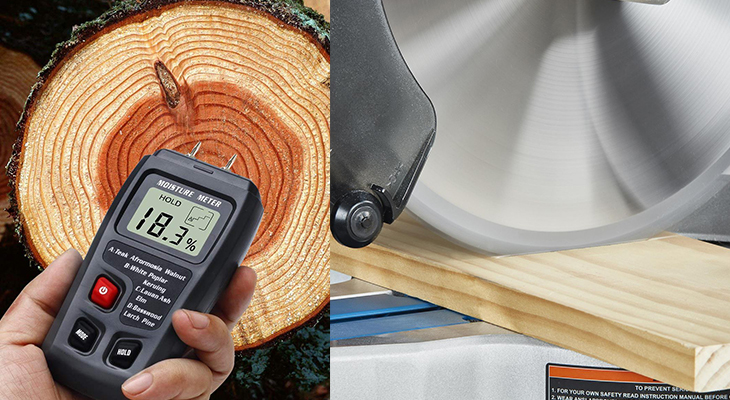Moisture? Measure twice, cut once!

Working on wood is an art and a science. But the simplest woodworking mistakes can cost valuable time, money, and possibly future projects. Many common mistakes can be avoided with some forehand knowledge about wood and its nature.
Wood fibres constantly absorb and release moisture. The temperature and relative humidity of the surrounding air always impacts the moisture content of the wood. Finishes – such as sealants, stains or paints – can limit how much moisture moves between the atmosphere and wood, but it doesn’t stop the trans-location.
In dry environment, the moisture in the wood evaporates into the air around it. This can cause boards to shrink and crack. Gaps can appear at the joints. On the other hand, if there’s a lot of moisture in the air, the wood will absorb it. The wood can thus swell, causing buckling or splitting.
In either case, drawers, cabinets and door frames can start to deform and not fitting. Even pieces that aren’t framed, such as in tables, can form separations and cracks that ruin the aesthetic value of a piece of furniture.
It is scientifically proven that any piece of wood needs to acclimatise to its surroundings – where it will be milled, sawed or moulded – before work can begin on it.
Climate control
However, it is incorrect to assume that because a certain amount of time has elapsed, the wood must be acclimatised. The only way to know if the wood has reached a safe moisture level is to measure its moisture content with a moisture meter.
In most cases, you can help mitigate mistakes during the production process, but not so with moisture. Especially because excess moisture doesn’t show up until after the piece is finished in the workshop and is already in someone’s home!
The result: the furniture piece turns ugly; drawers and doors can stop fitting; and legs can become uneven. Working with wood that holds excess moisture makes the final product unusable.
The air temperature and relative humidity of the in-service location are the key factors in determining the proper moisture content range for the wood. For an air-conditioned indoor space, that usually means getting the moisture content of the wood between 6% and 8%.
However, if the piece is intended to stay outdoors, then you need to account for the variations in ambient conditions because those changes will affect the wood.
A reliable wood moisture meter takes the guesswork out of it. Once you know the target moisture content range for the in-use location, you can use a high-quality moisture meter to verify the wood is in this range.
The only way to rectify excess moisture issues is to avoid them before you begin working. Some wood moisture meters include a function that will even calculate what an area’s target moisture content range should be!
Improper measurement is another obvious mistake to be aware of. Not acclimatising the wood can also result in mis-measured wood. Giving the wood the time it needs to acclimatise before measuring it for use will help keep all pieces in the right proportion.
Correct tools
Using the wrong tools for the job invites a beehive of mistakes that might not be possible to correct later. Even using a planer when the job calls for a sander can mean the wood is now misaligned.
Learn about the wood species you’re using and what tools, including saw blade or router sizes, will work best for it.
Bad saw blade choices are another common mistake – whether due to your misjudgement, technical ignorance or attempt to avoid investing in more appropriate and costly blades.
Why would you use a dull blade on your work piece? Dull blades encounter a lot of resistance, causing high friction. They need more force to cut through the wood, which can result in split wood, a broken blade, or dangerously mishandling the saw.
As with the dirty or dull router, friction and resistance can create burn marks on the wood. Dull blades are also a safety hazard. As a thumb rule, the more teeth in the blade, the finer will be the cut.
Kerf is the width of the cut created by the saw blade, not the width of the saw blade. You can start with a small, partial cut to measure the kerf on a board. With that information, you can confirm or adjust each cut as needed to get the right dimensions.
Comments

- Digital lacquer embossing for flooring from Hymmen
- Weber sanders help achieve luxury surfaces
- UF resin: blessing in disguise
- Cost savings for new factory investments
- Forest management for sustainable supply from B.C. Canada
- Egger’s ‘Capsule Concept’ creates harmonious décor
- Grass releases RAT system for cabinetry
- State-of-the-art edge bander from Jai
- SCM’s Balestrini centres for solid wood
- Sugatsune introduces new concealed hinge for doors
- Aryamman brings home Konrad Hornschuch products
- Automatic beam saw with twin pusher from Woodtech
- Seamless functional doors from Fiamarc
- Felder offers range of wide belt sanders
- OptiSaw 3.2 Panel Saw
- New guidelines to curb ‘green-washing’
- Ozone opens Experience Centre in Bengaluru
- Dieffenbacher takes over Schmidt & Heinzmann
- Egger invests in sustainability and automation
- Demand for American Oak soars in India
- Nitori to open first store in India
- Bureau Veritas acquires AI company
- Siempelkamp secures syndicated loan
- Merino to reduce carbon footprint
- Ebco’s new campaign features ‘Boom-Boom’ Bumrah
- SCM wins SMAU innovation award
- Unilin wins patent for flooring
- WhatsApp kicks off training for businesses
- SCM takes over Mecal Machinery
- Rajesh Mittal to head FIPPI
- Birla Opus opens fourth paints factory
- Greenply roots for ‘Pushpa 2’
- Wooden Street raises ₹354 cr. in funding
- Ashima Kaul recognized as top HR Leader
- Dieffenbacher’s ‘Osiris’ set to revolutionise fibreboard recycling
- BIFMA: steps to attain global industry standards
- In Silver Jubilee year, propelling growth remains the ‘mantra’
- PHANTOM HANDS
- ‘Fevicol Pro series is disruptive innovation’
- Furtech Show 2025 returns to Dubai in September
- Vert: the red-oak route to a cool-cool city
- Moisture? Measure twice, cut once!
- ‘Mirka has solutions for today, tomorrow, thereafter’
- On 50th anniversary, Ligna has more on offer
- Ukrainian designer redefines function through form












































